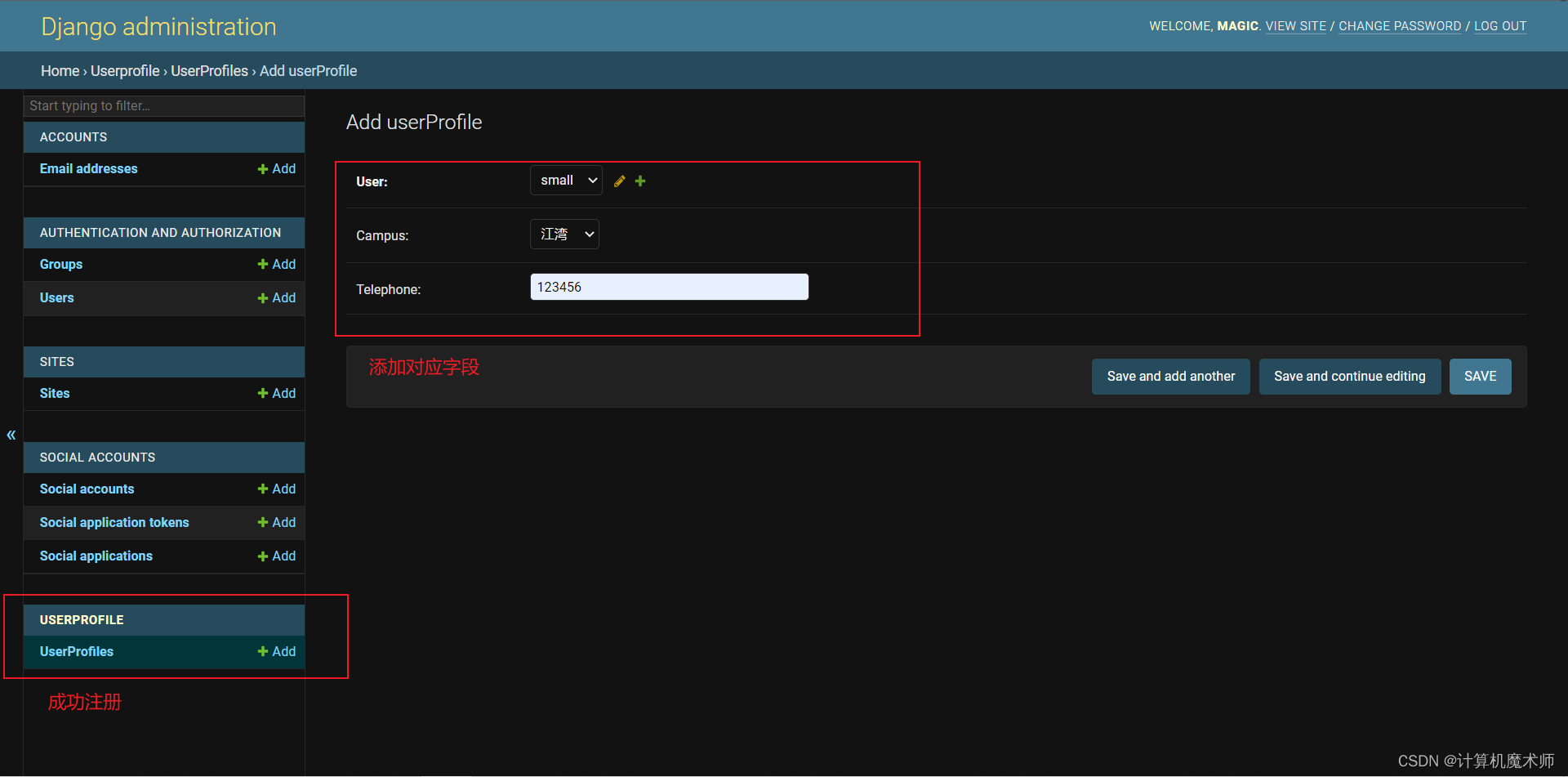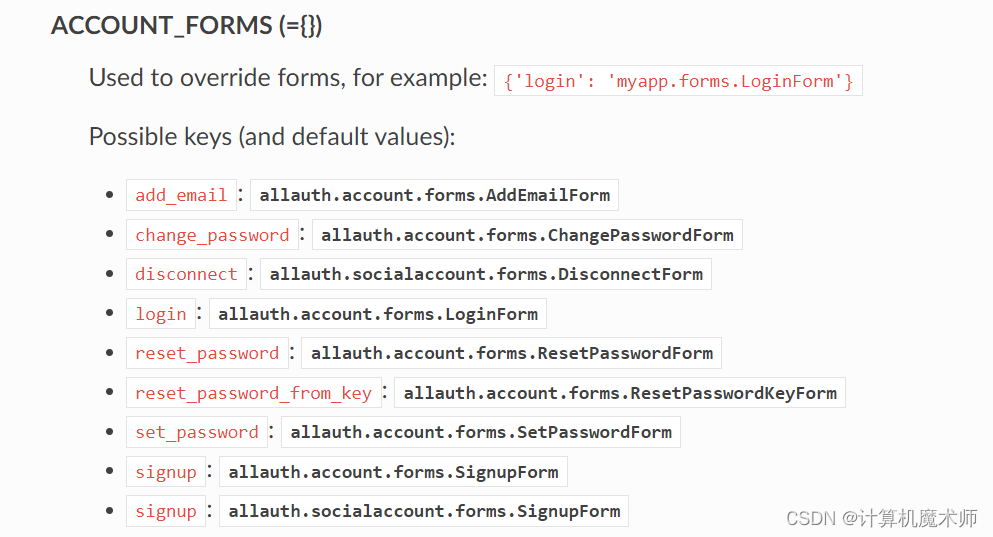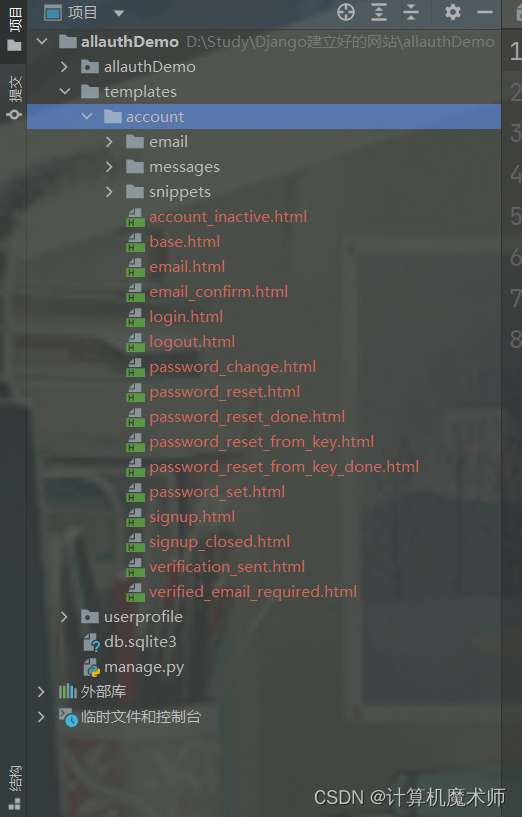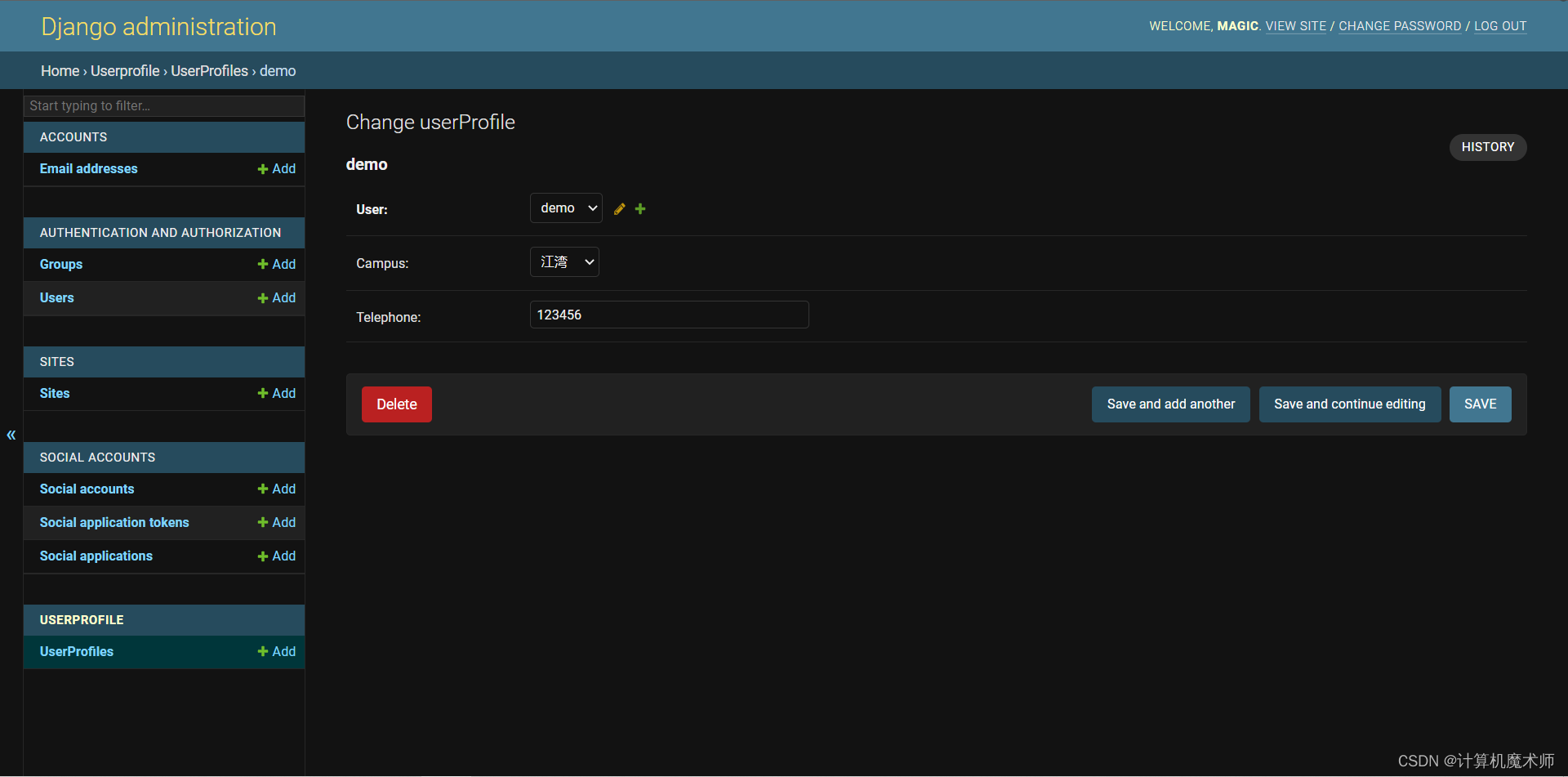
该文章收录专栏
✨—Django从(图文并茂轻松上手教程)专栏—✨!!🎏内容:
✨《Django第二章之增删改查》✨
✨《Django第一章之项目搭建》✨
文章目录
一、配置项目& 创建文件
创建应用
users
python manage.pu statrapp userprofile
在项目
setting
文件加上app
...'allauth','allauth.account','allauth.socialaccount',"userprofile"]
- 注意!!!: 在 引入 扩展模型应用路由时 allauth应用 和 userprofile 谁在上方一定要考虑好,不然路由覆盖等会出现页面失效或者报错的情况!!(一般默认allauth在上方)
项目 urls.py
from django.contrib import admin
from django.urls import path, include
urlpatterns =[
path('admin/', admin.site.urls),
path('', userprofile.views.profile),# 首页 则为信息页(当未登录 自动跳转到login页)
path('accounts/', include('allauth.urls')),
path('accounts/', include('userprofile.urls'))]
在
userprofile
应用的
models.py
创建扩展模型(添加字段)
from django.contrib.auth.models importUser
from django.db importmodels#Create your models here.classUserProfile(models.Model):
user = models.OneToOneField(User, on_delete=models.CASCADE, related_name="profile")
CAMPUS_CHOICE =(('江湾','江湾'),('河滨','河滨'),('仙溪','仙溪'))
campus = models.CharField(choices=CAMPUS_CHOICE, max_length=10, verbose_name='campus', blank=True)
tel = models.CharField(max_length=20, verbose_name='telephone', blank=True)classMeta:#admin名称
verbose_name ='userProfile'
db_table ='userprofile'
def __str__(self):return'{}'.format(self.user.__str__())
- 在
admin文件 注册UseProfile模型
from django.contrib importadmin
from userprofile.models importUserProfile#Register your models here.
# 原生注册
admin.site.register(UserProfile)
- 三板斧启动服务器(现使用sqlite 数据库,后面再迁移至mysql)
python manage.py makmigrations
python manage.py migrate
python manage.py runserver
- 注册成功

二、 建立表单
在应用下建立文件
forms.py
,并重写表单,
由于注册表单时,只会自定创建user对象,并没有创建userprofile并自动与扩展模型userprofile 进行关联,所以需要重写注册表单,并修改默认注册表单配置,注册时两个对象一起被创建,并存储到数据库中。这点非常重要。通过重写表单,你还可以很容易添加其它字段。
from django importforms
from userprofile.models importUserProfileclassUseProfileForm(forms.Form):
CAMPUS_CHOICE =(('江湾','江湾'),('河滨','河滨'),('仙溪','仙溪'))
tel = forms.CharField(label='Your telephone', max_length=20, strip=True, required=False)
campus = forms.ChoiceField(label='Your campus', choices=CAMPUS_CHOICE, required=False)
2.1 重写注册表单
有两种方法实现
1)自定义表单类 (这里的需求是需要附加输入,建议使用这种方法)
注意!!! : 自定义表单 在配置好之后,是直接引入到allauth.account,forms的,这个时候是不能使用 重写的继承方法的!,不然引入父类的操作会陷入调用循环!
- 原理: allauth应用 根据setting中的
account_signup_form_class的值(路由)引入该表单类,将该表单类的方法siginup替换掉原生注册表单
# 自定义表单classSignupForm(forms.Form):# 对某方法进行重写,注意名字
def signup(self, request, user):user_profile=UserProfile()
user_profile.user = user
user.save()
user_profile.save()
- 在
setting加上表单配置
ACCOUNT_SIGNUP_FORM_CLASS ='userprofile.forms.SignupForm'
2)重写表单( 继承表单类)

- 不需要和自定义一样引入表单,直接定向到该表单(所以不会出现引用循环)
# 继承(继承用法,保证其 重写注册表单,重联系二者classCustomSignupForm(SignupForm):# 对某方法进行重写,注意名字
def custom_signup(self, request, user):user_profile=UserProfile()
user_profile.user = user
user.save()
user_profile.save()
- 在
setting加上表单配置
ACCOUNT_FORMS=({'reset_password':'userprofile.forms.ResetPasswordForm','signup':'userprofile.forms.CustomSignupForm'})
三、 view 视图函数与 URLs
- userprofile 的
urls.py
from django.urls import re_path
from userprofile import views
urlpatterns =[
re_path(r'^profile', views.profile, name='profile'),
re_path(r'^profile/update', views.profile_update, name='profile_update')]
views.py
from django.contrib.auth.decorators importlogin_required
from django.shortcuts importrender, redirect, get_object_or_404,HttpResponseRedirect
from userprofile.forms importUseProfileForm
from userprofile.models importUserProfile#Create your views here.
@login_required()
def profile(request):
user = request.user
returnrender(request,'account/profile.html',{'user': user})
@login_required()
def profile_update(request):
user = request.user
user_profile =get_object_or_404(UserProfile, user=user)if request.method =='POST':
# 得到表单数据
form =UseProfileForm(request.POST)if form.is_valid():
user_profile.tel = form.cleaned_data['tel']
user_profile.campus = form.cleaned_data['campus']
user_profile.save()returnHttpResponseRedirect(reverse('PetProfile:profile'))else:
default_data ={'tel': user_profile.tel,'campus': userprofile.campus
}
form =UseProfileForm(default_data)
# 如果时get 返回查看
returnrender('account/profile_update.html',{'form': form,'user': user})
- 特别注意!!: 之前文章所注册的用户,在注册时没有生成
userprofile对象,在user_profile = get_object_or_404(UserProfile, user=user)这里会报错,所以我们得先注册一个新用户。(修改了注册表单)
四、 创建proflie模板和proflie_update模板
在
allauth
包中复制粘贴
templates
的
account
包到该项目的
templates
的
account
下,原因:
- 便于模板覆盖
- 便于修改表单

- 添加
profile.html文件
{% block content %}
{% if user.is_authenticated %}
<ahref="{% url 'userprofile:profile_update' %}">Update Profile</a> | <ahref="{% url 'account_email' %}">Manage Email</a> | <ahref="{% url 'account_change_password' %}">Change Password</a> |
<ahref="{% url 'account_logout' %}">Logout</a>
{% endif %}
<p>Welcome,{{ user }}</p><ul><li>name:{{ user.first_name }}</li><li>telephone:{{ user.profile.tel }}</li><li>campus:{{ user.profile.campus }}</li></ul>
{% endblock %}
- profile_update.html
{% block content %}{%if user.is_authenticated %}<a href="{% url 'userprofile:profile_update' %}">Update Profile</a>|<a href="{% url 'account_email' %}">Manage
Email</a>|<a href="{% url 'account_change_password' %}">Change Password</a>|<a href="{% url 'account_logout' %}">Logout</a>{% endif %}<p>Welcome,{{ user }}</p><div class="form_container"><form method="post" action="" enctype="multipart/form-data">{% csrf_token %}{%for field in form %}<div class="form-item">{{ field.errors }}{{ field.label_tag }}{{ field }}{%if field.help_text %}<p class="help">{{ field.help_text|safe }}</p>{% endif %}</div>{% endfor %}<div class="button-submit"><input type="submit" value="Update"/></div></form></div>{% endblock %}
五、登入admin管理系统
- 特别注意!!: 我们在登录用户之后,此时系统是记录我们的用户信息的,而此时如果我们更改路径到admin中,输入我们的管理员账号会报 提供了两个参数的信息,这是因为管理员的用户信息和当前用户信息冲突了,需要
signout当前用户
当输入密码错误时也会报和上面一样的错误(当时调试了好久😂)
- 效果:

参考文献:
扩展用户自带模型(allauth)
扩展用户自带user模型(非allauth实现)
外键related_name
def _ str_ (self)
def _ str_ (self)
verbose_name
表单模型和表单的使用
✨谢谢你的阅读,你的点赞和收藏是我创作的最大动力✨
版权归原作者 计算机魔术师 所有, 如有侵权,请联系我们删除。
